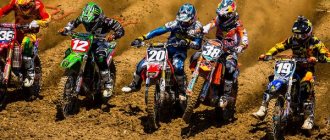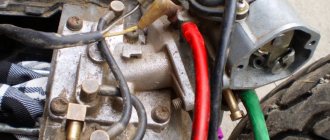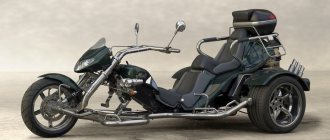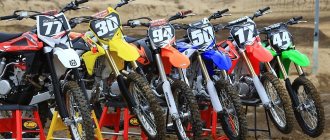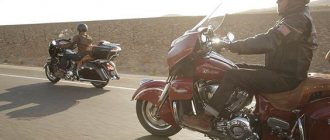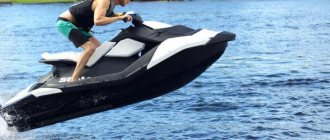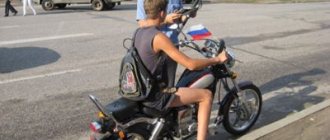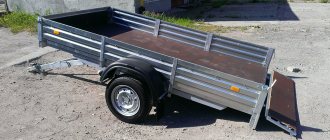What is a Superbike?
A superbike (or, as it is otherwise called, a sportbike) first appeared in America in the 60s of the 20th century. The modern understanding of this term is interpreted as follows: “circuit racing on road sports motorcycles.”
It should be noted that the first World Championship, which was held in 1988, brought enormous popularity to this sport. Its winner and first champion was an American named Fred Merkel, who competed in a Honda.
Features of motorcycles for competitions
What are the features of the motorcycles whose owners are going to try their hand at a superbike? When creating them, you need to rely on just one simple rule: only serial sports models should be taken as a basis, and modernization can be carried out with any available parts (which, of course, can be found on the open market). However, such bikes cannot be ridden on public roads.
The most popular models are produced by such famous Japanese brands as Kawasaki, Suzuki, Honda and Yamaha. It's not uncommon to see Italian Ducatis or find German BMWs. In addition to those mentioned, competition participants may give preference to other brands.
Competition classes
In order to thoroughly understand the features of superbike racing, you should know the typical classes of competition:
- Superbike is considered the highest class. It involves highly modified models with a 2-cylinder 4-stroke engine (the volume of which does not exceed 1200 cm3), or a 4-cylinder engine (750-1000 cm3). Important: here the installation of racing tires (“Slicks”) is a mandatory parameter.
- Supersport (in English it sounds like “Middleweight”) is a “middle-class” race, which usually involves 4-cylinder motorcycles (engine capacity does not exceed 600 cm3) or 2-cylinder “cc models” (up to 750 cm3). In this class the number of modifications is significantly less compared to the previous one. The most important difference is the use of only standard road tires.
- Superstock (the English version is “Lightweight”) is the simplest class, traditionally considered a kind of gateway to the world of circuit racing. The conditions are as simple as possible: the motorcycle models are slightly modified; regular production models with engines up to 1000 cm3 can be used.
Each athlete can choose a class for themselves depending on their skills, features of the motorcycles they use and other parameters.
Althea BMW Racing Team / BMW S 1000 RR STK – FIM STK 1000 Cup
The FIM Superstock class brought BMW Motorrad its first big success in the modern road racing programme. Shortly after the release of the S 1000 RR, Ayrton Badovini won the championship by an incredible margin, which gave the new motorcycle excellent publicity. Especially among amateurs who drive equipment of this level. This year the S 1000 RR excelled again in Superstock. Raffaele De Rosa came third three times, won stages twice and eventually took first place in the championship standings. This once again demonstrated that a stock motorcycle can go very fast.
The design requirements in FIM Superstock are very stringent. The motorcycle should be as close to stock as possible. Apart from plastics and controls, which do not affect driving performance, a strictly limited set of parts such as the shock absorber, fork cartridges (while retaining the original outer pipes), and brake pads (while retaining the calipers) are changed. Electronics and software are only available to ordinary users. And in this regard, BMW seriously outperforms its competitors. The S 1000 RR is equipped with hardware that allows you to delve very deeply into the motorcycle’s settings using special “software” (sold at every dealer). It also has serious datalogging capabilities, without which modern circuit motorsport cannot fully operate. The result is a motorcycle that seems to be simple and inexpensive, but still very fast. Unlike mega-boosted superbikes, it runs smoothly and is well controlled. In general, it functions as a standard one, that is, it is understandable not only to a top championship driver, but also to an ordinary person.
Major superbike competitions
The most important and significant competition is the World Championship (Superbike World Championship). This is a fairly significant event that takes place on an ongoing basis. The race consists of several stages, each consisting of two large races. Over time, the conditions of the championship changed, and Superpole was added there - a 10-lap sprint.
However, the World Championship is not the only serious superbike competition. There are also equally popular superstock and supersport competitions. In addition, many countries hold their own competitions, which are in no way inferior to the World Championship in their grandeur. The following can be especially highlighted:
- Moto America Superbike Championship, which is traditionally held in the States.
- British Superbike Championship, held in Great Britain.
- Australian Superbike Championship, held in Australia.
- All Japan Superbike Championship is a very large-scale race in Japan.
Russia also has its own races called RSBK (Russian Superbike). It should be emphasized that RSBK is not some local competition, but a significant sporting event that is supported by the Russian Motorcycle Federation.
In the Russian Federation, the first Championship was organized in 2012 and has been held annually since then. RSBK consists of two tests, which are conducted in seven classes. Included are such areas as Open Stock, Supersport, there is a separate class only for the fair sex.
Penz13.com BMW Motorrad Team / S 1000 RR SBK – EWC
Endurance is one of BMW Motorrad's favorite disciplines. Even when the Bavarians did not have any circuit program, boxer motorcycles performed at Le Mans, Oschersleben and Suzuka, surprising spectators with the bizarre light of headlights mounted on cylinders sticking out to the sides. With the introduction of the S 1000 RR, the presence in endurance racing has become much more representative. The motorcycle performed well in the stock class, and this season achieved some success in Superbike, won pole position in the 24 Hours of Le Mans and a final third place in the Eight Hours of Oschersleben. It is also notable for the fact that our compatriot Andrei Ivanov worked on the team of mechanics.
The main external distinguishing feature of the WEC motorcycle is the headlights. They are real and they work, since the races also take place at night. Accordingly, all this illumination is equipped with a large number of switches on the steering wheel and nearby. There are also enough other buttons; there is something for the pilot to press during a long race. Falls happen at Endurance races, and this is a normal situation, after which you need to get to the pits so that the mechanics can fix the motorcycle as quickly as possible. When the entire race lasts 24 hours, losing a few minutes is not critical. Therefore, when building a motorcycle, there are two important goals that are ignored in short races: the motorcycle must be as strong as possible and suitable for quick repairs. Therefore, the most vulnerable parts such as footrests, clip-ons, plastic, and forks are optimized for quick dismantling. Even the brake hoses have connectors embedded in them, which allow you to instantly remove and install calipers without bleeding the system.
In terms of rideability, the motorcycle is also surprising. It seems that for long hours of driving it should be made as stable as possible. In practice it is very rolly. So much so that it’s difficult to even drive in a straight line, constantly trying to fall. Every, even the most imperceptible movement of the steering wheel causes a nervous reaction of the entire chassis. This phenomenon is common in the racing world, and within a couple of laps it becomes addictive. Otherwise, the motorcycle is comfortable, you can immediately see that the ergonomics were designed so that the pilot retains his reserve of strength for as long as possible. It’s good to rest on it, leaning your stomach on the large tank and resting your hands on the wide steering wheel. Because the speeds are slightly lower than in sprint racing and the driving modes are less exhausting, the torque curve is shifted downwards. Therefore, the engine seems more powerful than other motorcycles, although in practice it produces less power.
Requirements for participants
Requirements for participants depend on the specific competition.
There are conditions for potential participants in interregional official superbike competitions on the territory of the Russian Federation:
- Only one team from one subject of the Russian Federation can submit an application.
- The age of participants for the superbike class is from 18 to 62 years.
- For some disciplines (Supersport, Supermoto 250, Supermoto 450) athletes who are at least 15 years old are allowed. Licenses for such participants are issued after passing special exams.
- Athletes from 14 years old can participate in the Superstock 400 class. However, here too, to participate, you first need to pass an exam.
Conditions may vary depending on the type of competition. Therefore, before submitting an application, you should read the text of the conditions.
Conditions of the competition
The racing conditions will be considered using the example of RSBK. It should be noted that other competitions may differ in this part. At each stage there are the following types of races, which are divided into preparatory training and races:
- First, there is free training, which participants call practice. Their number is indicated in the regulations of each stage. The duration of each practice usually does not exceed 15 minutes.
- Secondly, this is a qualifying race (one or more), which lasts at least 15 minutes. It is he who distributes the starting positions.
- Thirdly, the final race. It is separate for each motorbike class.
Important : To take part in the final race, during practice or qualifying you must show a lap time within 115% of the best time of the leader in your class.
The rules set for the World Cup are significantly different.
- Two practices of 60 minutes each on Friday and Saturday, then two qualifications (also 60 minutes each), depending on the results of which the starting position of each participant during the first race is determined.
- Two races that are held with a two-hour break, which most participants use to their advantage. Mostly athletes make changes to the settings of their bikes.
- Each distance is set between 90 and 110 km. On average, participants take no more than 45 minutes to complete it.
Most racing cars easily reach speeds of about 300 km/h in competitions.
BMW Motorrad racing program
BMW Motorrad is the youngest of the major manufacturers involved in motorcycle road racing. If we do not take competitions from the distant past and individual experiments with one-piece “opposite” bikes, the modern Bavarian “ring” program is only seven years old, like the S 1000 RR sportbike. Its essence is somewhat different from what competitors do. BMW does not strive to win victory in elite sports at any cost; the plant is not represented in MotoGP at all; support for WSBK is much more modest than that of other industry giants. Instead, resources are spent on increasing presence in national championships and amateur series. Development comes from different directions. To make it easier to work with the equipment, technical support is provided. Even in standard configuration, the motorcycle can go very fast. And with the help of ready-made sets of hardware and software, which are sold at dealers, it is brought to a level that allows it to take high places in local and international championships. This is confirmed by professional racers using the same Race Calibration Kit and Race Power Kit that are available to any S 1000 RR owner.
Modern racing equipment is not enough to buy, it must be configured. To facilitate the process, a staff of consultants is provided. They answer questions by phone and email, and if urgently needed, they can set up electronics remotely. Another direction is the formation of a racing community. The BMW Motorrad Race Trophy is something of a correspondence championship for S 1000 RR pilots. They compete in their own racing series and collect points, which are summed up according to a special system using coefficients. At the end of the season, a single table is compiled, and the leaders receive a monetary reward that covers part of the costs for the season. This policy has been working for several years, and the Bavarians have already managed to achieve serious results. It's hard to imagine competitions or track days without the S 1000 RR. About 30% of BMW sportbikes are raced on the track. The 2021 BMW Motorrad Race Trophy includes 20 racing series, 25 countries, 129 drivers, 84 tracks, 289 races. BMW drivers scored 84 victories and 251 podium finishes. Future plans are to increase the number of teams to 200, as well as increase the professionalism of service personnel through a training program. So in the near future there will be more S 1000 RRs on the tracks, they will be faster and more reliable.
Fast and pack > December 21, 2021 19:44 Nikolay Bogomolov
Defining Results
If we take RSBK as a basis, then you can become the winner of the competition in two categories at once: the first is among drivers, and the second is among manufacturers. The judging of the races is provided by organizations such as the IMF (International Motorcycle Federation) and the IMF (Motorcycle Federation of Russia).
The World Championship has a fairly common system that awards points according to the following principle: 25, 20, 16, 13, 11, 10, 9, 8, 7, 6, 5, 4, 3, 2, 1. The total for one race is a certain Only 15 riders can receive points.
Althea BMW Racing Team / BMW S 1000 RR SBK Worldsbk
BMW's successes in World Superbike are noticeably more modest than in other racing series. Which is not surprising, since the manufacturer came and went, and now has again settled in the class of the fastest racing motorcycles built on the basis of standard ones. This season, promising driver Jordi Torres finished fourth three times, and his teammate Markus Reiterberger's best result was fifth. For a long time we were afraid that World Superbike motorcycles would be strangled and brought as close as possible to stock ones. They were scared in vain. The engines can still be seriously modified, so combined with the serious power of the standard version, the result is more than enough to drive in the top five of the World Championship.
And for an ordinary person, not burdened by the baggage of big sport, the engine characteristics are even too much. Moreover, the bulk of the horsepower was collected in the upper part of the operating range. From below, the engine is nervous: at first it drives slowly, then it starts to shoot sharply. Even leaving the pit lane was not easy: neutral was not caught, I had to start and start in gear, then the motorcycle jerked the engine and at the same time wanted to fall over, since the chassis is designed for turns even more than that of an extremely rolly World Endurance series superbike. It becomes calmer on the track. Having spun up beyond 10,000 rpm, the engine gains predictability and smooth operation. It’s just scary to spin it up to the red zone, as the elite do: acceleration becomes more intense than necessary. The throttle handle is also very short. It’s good to have this on a 600, but with a power of 220+ you want more control. You also need to get used to the chassis. Within the few laps that we were given to get acquainted with this technology, it turned out to be unrealistic to experience the features of a racing chassis of the highest level. As soon as you stop being afraid and start to improve a little, it’s time to go to the pits. One thing is for sure: this is not a bike for slow riding. While a hobbyist feels comfortable on a stock bike and understands what to do, the S 1000 RR WSBK is complex and incomprehensible, a motorcycle that needs to be specially learned to ride.
The race organizer has the right to place his own and official advertising on all motorcycles participating in the competition. Athletes participating in races do not have the right to refuse the Organizer to fulfill its obligations to advertiser-sponsors.
There should be no more than three advertising stickers, and the area of each should not exceed 140 cm². The rider must place the advertisement in a visible place and not cover it with his body while driving the motorcycle. An athlete’s refusal to comply with these conditions may result in a fine or inadmissibility to competitions. In turn, the advertisement to be placed must be censored and not offensive.
History of superbike racing
The Superbike World Championship is one of the largest and most popular superbike sports competitions that takes place in Europe, the USA and Australia. It is worth noting that until the beginning of the 2000s, races were also held in Japan.
The first Superbike Championship was held in 1988 by the International Motorcycling Federation. The first world champion in superbike racing was American representative Fred Merkel. An interesting fact is that Ducati was recognized as the “lucky” motorcycle brand. This is due to the fact that it was there that over 10 titles at the World Championship were won. As it became known later, this brand had a special advantage - a two-cylinder model with an engine capacity of up to 1000 cm³, while Japanese manufacturers had a displacement of four-cylinder motorcycles of 750 cm³.
In 2003, the engine displacement requirements were revised by the competition organizers, and the Italian motorcycles from Ducati were deprived of their advantage, since the engines of all motorcycles were equalized in volume up to 1000 cm³. After the introduced changes, the palm periodically passed from one brand of motorcycle to another: Honda, Suzuki, Kawasaki. One of the most successful racing drivers in the first two decades since its recognition as a sport was Carl Fogarty. He managed to win the world title four times, while he has 59 victories in 11 seasons in superbike races.
In conclusion, it should be noted that since the birth of the Superbike discipline, despite the dangers of competition, it has been a very popular sport with thousands of athletes and loyal fans.
Targobank Easyrace SBK Team / BMW S 1000 RR SBK – CEV
CEV is one of the local championships, the level of which is actually much higher than that of an ordinary national competition. The Spanish championship even formally has European status, but in fact the strongest racers on the planet gather there. It was from CEV that Jorge Lorenzo, Marc Marquez and even Casey Stoner came out, even though he was born on the other side of the Earth. The most prestigious classes are Moto 3 and Moto 2, but Superbike also enjoys great prestige. This season, the BMW S 1000 RR driven by Maximilian Schaiba won two races, achieved a total of nine podium finishes and eventually finished ninth in the championship.
Despite its superbike status, modification of the motorcycle is seriously limited. The engine design is almost entirely standard; the most serious change at the hardware level is the full Arrow exhaust system. But a lot of work has been done to configure the electronic parameters using the BMW Race Power Kit and Race Calibration Kit software.
As a result, compared to the standard motorcycle, the anger noticeably increased. The already fast S 1000 RR has become even faster and sharper. At some point, on a hilly section when approaching a descent, he even tried to roll over his rear wheel. But Wheelie can be neatly extinguished with the help of a very useful device, the rear brake lever located under the left thumb. This system is also useful in aerobatics, such as maintaining high revs while leaning while gradually adding thrust by releasing the brake rather than applying the throttle. But this is already a tool for professionals, and for simpler riders, the ability to simply brake effectively with all wheels without using the right leg will be enough. Since the pilot is compact, at a height of 180+ it is not very comfortable to sit on a motorcycle; you have to fold it up a lot. For some reason, the footrests are very short, so that out of habit, the leg loses support.
